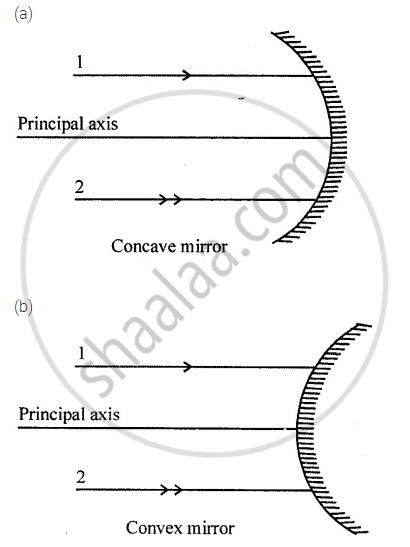Advertisements
Advertisements
Question
Choose and write the correct option.
If we gradually increase the angle of incidence of a ray of light passing through prism then …..
Options
Angle of deviation goes on decreasing.
Angle of deviation decreases but after certain value of incident angle, deviation angle increases
Angle of deviation goes on increasing.
Angle of deviation increases but after certain value of incident angle deviation angle decreases.
Solution
Angle of deviation decreases but after certain value of
incident angle, deviation angle increases.
APPEARS IN
RELATED QUESTIONS
Where is the image when you look at something in a mirror?
The letter F is placed in front of a plane mirror:
How would its image look like when seen in a plane mirror?
What are the important differences between looking at a photograph of your face and looking at yourself in a plane mirror?
Which type of reflection of light leads to the formation of images?
What type of reflection of light takes place from a cinema screen?
The boy walks towards the mirror at a speed of 1 m/s. At what speed does his image approach him?
State the uses of plane mirrors.
Define the following terms used in the study of reflection of light by drawing a labelled ray-diagram:
(a) Incident ray
(b) Point of incidence
(c) Normal
(d) Reflected ray
(e) Angle of incidence
(f) Angle of reflection
A man sits in an optician's chair looking into plane mirror which is 2 m away from him and views the image of a chart which faces the mirror and is 50 cm behind his head. How far away from his eyes does the chart appear to be?
A ray of light travelling in glass emerges into air. State whether it will bend towards the normal or away from the normal.
A ray of light goes from water into air. Will it bend towards the normal or away from the normal?
When a ray of light passes from air into glass, is the angle of refraction greater than or less than the angle of incidence?
In which material do you think light rays travel faster-glass or air?
Why does a ray of light bend when it travels from one medium to another?
What is meant by the 'angle of incidence' and the 'angle of refraction' for a ray of light?
Light travels more quickly through water than through glass.
Which is optically denser : water or glass?
A coin in a glass tumbler appears to rise as the glass tumbler is slowly filled with water. Name the phenomenon responsible for this effect.
Name the phenomenon due to which a pencil partly immersed in water and held obliquely appears to be bent at the water surface.
State two factors on which the lateral displacement of the emergent ray depends.
Water is optically denser than glass.
A ray of light when passes from glass to air, bends towards the normal.
Air is optically .......... than glass.
When a ray of light travels from air to glass, it bends .......... the normal.
Draw a diagram showing the refraction of a light ray from water to glass. Label on it the incident ray, the angle of incidence (/), and the angle of refraction (r)
The diagram (figure) given below shows two parallel rays 1 and 2 incident on (a) a concave mirror, (b) a convex mirror. Draw the reflected rays and mark the focus by the symbol F.

A light ray suffers reflection and refraction at the boundary in passing from air to water. Draw a neat labelled ray diagram to show it.
Explain how the formation of a rainbow occurs.
Light changes its direction when going from one transparent medium to another transparent medium. This is called _______.
If a beam of red light and a beam of violet light are incident at the same angle on the inclined surface of a prism from air medium and produce angles of refraction r and v respectively, which of the following is correct?
The phenomenon of light passing through the object is called ______.
A ray of light traveling in medium 1 strikes and travels into another transparent medium 2. If the speed of light is greater in medium 1, the ray will ______.
A star appears twinkling into the sky because of the reflection of light by the atmosphere.
Twinkling of stars and Mirage are the two phenomena occurring due to refraction.
Match the following:
| Column I | Column II | ||
| 1. | r > 90 | a. | Light gazes at the surface of separation between the two modes. |
| 2. | r = 90 | b. | No refraction. |
| 3. | r < 90 | c. | Refracted ray away from the normal |
